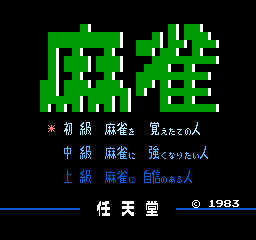

The title screen has a seemingly innocent line at the bottom - "TOP +28 100". +28? That's a pitiful score! I can beat that easy!
And
several games later I finally got +10. Still pathetic, but better than the high score.
The course is diabolical, and the controls are primitive. There are 16 directions which you can face to take your swing, and quite often none of them are exactly the direction that you want. Fortunately, by using the classic power meter, you can finesse your shot to go the direction it needs to go. The winds are often tricky, and to make things even more difficult, if the ball lands in the trees it is out of bounds and adds a penalty stroke to the ever growing score. Another great difficulty is the lack of distance indicators to tell you how far away from the hole you are. The clubs also have no indication of their range, and the game does not help you select a club.
There is only one single player mode, but there is both stroke and match play for two players. The graphics are sufficient in most cases, although the fairways are all flat. The close up shot of the golfer is a nice touch as well. The sound alternates between annoying and acceptable. The slide-whistle effect when the ball goes up and down is not really necessary, although the thud of the ball is fairly decent. For a quick listen to one of the most annoying sounds ever - get a birdie. A high pitched beep sounds in celebration which is almost enough to make you wish you had a bogey.
Even though this is a bit of a primitive golf game, it is quite a bit of fun once you get the hang of it. Recommended if you enjoy golf games in general.

 Pac-Man in hell. That's the quick synopsis of this bizarre game. You are some manner of lizardish thing who must pick up hell-dots while avoiding one-eyed creatures.
There are a few important differences from Pac-Man. The first is that your creature can't just pick up dots on his own. He requires the help of Devil World's power pellets - crosses. Picking up a cross allows you to eat dots. They remain even after they are picked up. They also give you the ability to shoot fire, which is the way you can turn the enemies into something that you can eat. The other change is that the playing field scrolls around, restricting your freedom of movement. The devil at the top stamps his foot and the field starts to scroll in a different direction. Getting caught between the edge of the screen and one of the walls will cause a life to be lost.
There are a few different kinds of levels. The first is the eat the dots type. The second has your lizard picking up books from the corners of the screen. The books must be taken to the stone in the center of the screen. There are also bonus rounds where you are given only a short amount of time to pick up items for points.
This game is one of the few variations on Pac-Man that actually has enough differences to make it a new experience. Keeping track of the scrolling playfield, and having to always have a cross active makes the game a tense experience. Also, the change of having to shoot the enemies mean that just because a power-up is active you aren't necessarily safe. Lots of fun, highly recommended.
Pac-Man in hell. That's the quick synopsis of this bizarre game. You are some manner of lizardish thing who must pick up hell-dots while avoiding one-eyed creatures.
There are a few important differences from Pac-Man. The first is that your creature can't just pick up dots on his own. He requires the help of Devil World's power pellets - crosses. Picking up a cross allows you to eat dots. They remain even after they are picked up. They also give you the ability to shoot fire, which is the way you can turn the enemies into something that you can eat. The other change is that the playing field scrolls around, restricting your freedom of movement. The devil at the top stamps his foot and the field starts to scroll in a different direction. Getting caught between the edge of the screen and one of the walls will cause a life to be lost.
There are a few different kinds of levels. The first is the eat the dots type. The second has your lizard picking up books from the corners of the screen. The books must be taken to the stone in the center of the screen. There are also bonus rounds where you are given only a short amount of time to pick up items for points.
This game is one of the few variations on Pac-Man that actually has enough differences to make it a new experience. Keeping track of the scrolling playfield, and having to always have a cross active makes the game a tense experience. Also, the change of having to shoot the enemies mean that just because a power-up is active you aren't necessarily safe. Lots of fun, highly recommended.






































